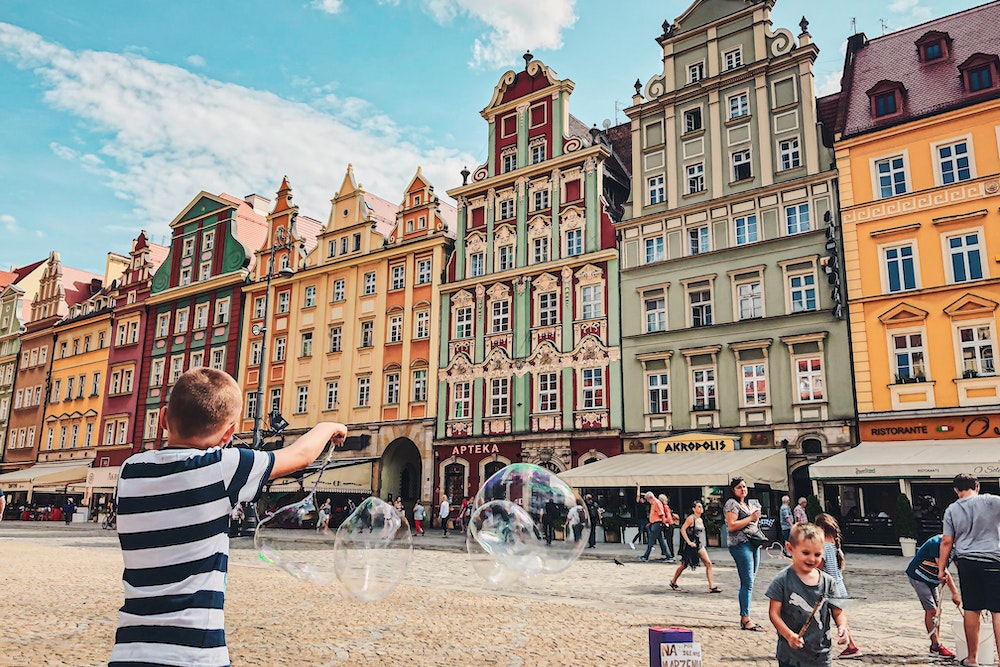Nestled on the banks of the Oder River, Wrocław, Poland’s fourth-largest city, carries the aura of a vibrant cultural hotspot with a rich historical tapestry. Each brick and cobblestone of this city whispers tales of its multifaceted past, where Polish, German, and Czech influences intertwine. Beyond its captivating history, Wrocław is a dynamic urban landscape bustling with world-class museums, architectural marvels, picturesque market squares, and an army of charming dwarfs. Let’s embark on an immersive exploration to uncover the hidden gems of Wrocław.
The magnetic charm of Market Square (Rynek)
Situated at the heart of the city, Wrocław’s Market Square, locally known as Rynek, exudes an irresistible charm that draws locals and tourists alike. As one of the largest market squares in Europe, Rynek is a perfect starting point for your Wrocław adventure.
The vibrant square is flanked by colourful, meticulously restored buildings that house a variety of restaurants, boutiques, and galleries. The stunning Gothic-style Old Town Hall, with its intricate astronomical clock, stands as a testament to the city’s architectural grandeur. Whether you choose to sip on a cup of coffee in a cosy cafe or simply stroll around enjoying the energetic atmosphere, Rynek offers a unique blend of the city’s past and present.
Ostrow Tumski: A journey back in time
Crossing the Oder River takes you to Ostrow Tumski, the oldest part of Wrocław. Known as the “Cathedral Island”, this area, though no longer an island, brims with spiritual tranquility and historical allure.
Here, you can find the stunning Wrocław Cathedral, a masterpiece of Gothic architecture with a history dating back over a thousand years. A climb to the top of the cathedral’s towers promises a breathtaking view of the city. As the day descends, witness the gas lamplighter, a sight rarely seen in modern times, lighting up the lamps one by one, casting a magical glow over Ostrow Tumski.
The Centennial Hall: A masterpiece of modernist architecture
Declared a UNESCO World Heritage site, the Centennial Hall stands as an architectural marvel and a symbol of the city’s resilience. Designed by Max Berg and opened in 1913, the structure’s innovative use of reinforced concrete and the vast circular interior were groundbreaking at the time.
Today, the hall serves as a venue for exhibitions, concerts, and sporting events. The surrounding park, Japanese Garden, and the multimedia Fountain of Wrocław add to the allure, making it an ideal spot for relaxation and recreation.
The alluring mystery of Wrocław’s dwarfs
One of the most delightful sights in Wrocław is the city’s beloved dwarfs. Scattered throughout the city, these small bronze figurines have become a significant symbol of Wrocław. Initially placed to commemorate the Orange Alternative, an anti-communist movement, these dwarfs have multiplied over the years, and spotting them has become a fun activity for visitors.
Each dwarf tells a story, adding a whimsical charm to the cityscape. From a dwarf sleeping on a windowsill to a pair withdrawing money from an ATM, these little creatures, much like the city itself, are full of surprises.
Exploring the unique Panorama of Raclawice
The Panorama of Raclawice is one of the most visited museums in Poland, housing an impressive cycloramic painting. This gigantic work of art, measuring 15 metres high and 114 metres in circumference, depicts the Battle of Raclawice, a significant event in Poland’s struggle for independence.
This 360-degree painting creates a feeling of being in the midst of the battlefield, providing an immersive historical experience. The skillful play of perspective, lighting, and realistic foreground brings the scene to life, making a visit to the Panorama of Raclawice a must when in Wrocław.
In conclusion, Wrocław is a city that gracefully combines the traditional with the modern, the whimsical with the profound. Its rich history, architectural wonders, and unique attractions make it a must-visit destination for travellers seeking to uncover lesser-known European gems.









